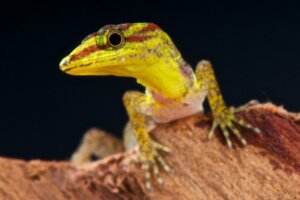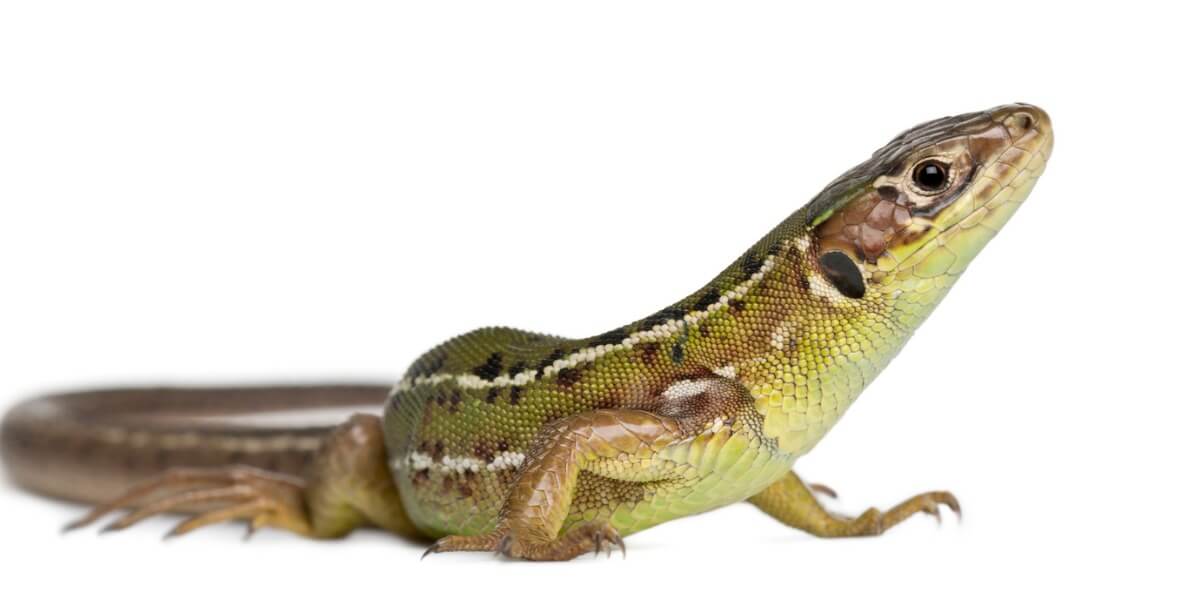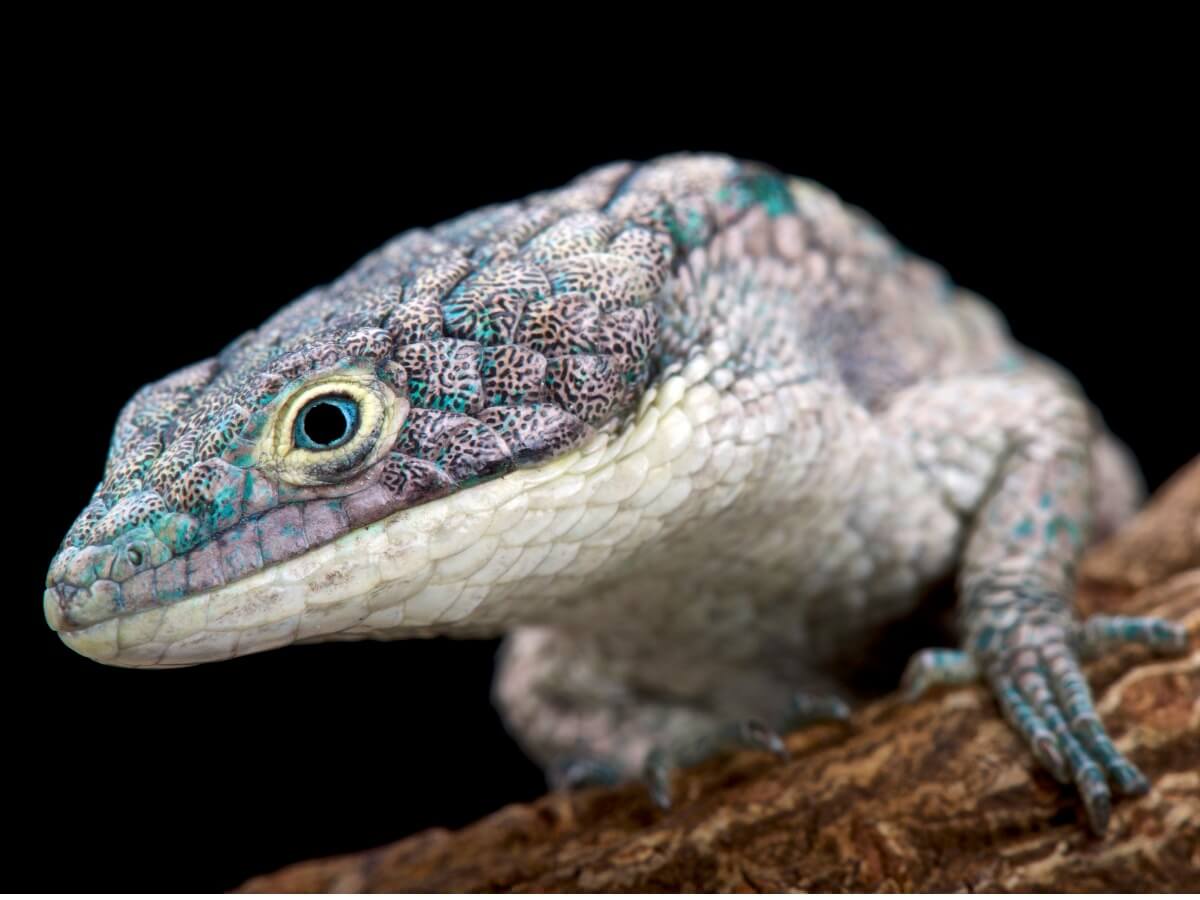How to Care For a Pet Lizard


Written and verified by the biologist Samuel Sanchez
The term lizard has no taxonomic analog. In other words, it doesn’t refer to a specific group and many small reptiles with elongated bodies can be called lizards. In countries such as Spain, lizards belong to the Lacertidae family, but in other regions they may belong to the taxa Gekkonidae, Teiidae and Tropiduridae, among others. Find out how to care for a pet lizard in this article.
Knowing how to care for a pet lizard depends on each individual case. It depends on the species to be cared for and the environment it requires in its terrarium. However, there are a series of parameters and general information that every owner should be clear about before getting one of these reptiles. Here we’ll tell you all about them.
1. Never take the animal from its habitat
It may seem tempting to “save” a lizard from a hostile environment and take it home. However, keep in mind that this is its home and its removal will do more harm than good. All wild animals are used to living in their natural environment, so putting them in a terrarium is a sure death sentence.
In addition to the ethical aspects of removing an animal from the wild, it’s worth noting that, in most countries, this act is considered illegal and punishable. Direct or indirect trade in exotic reptiles taken from the wild is a real problem and shouldn’t be encouraged in any way.
If you have a lizard living in your house or garden, the best thing you can do is to offer it a small bowl with water and some live insects sporadically. Let it roam free.

2. Choose a reputable source and learn about the species
The only option for keeping a lizard as a pet is to purchase it from a legal breeding facility or adopt it from an animal shelter. Once you decide to get one, ask for a certificate indicating the animal’s captive origin.
As mentioned above, the term lizard refers to the family Lacertidae, but also to several groups of geckos and other reptiles. In most cases, the specimens sold under this name belong to the family Gekkonidae (such as the tokay gecko or leopard gecko) and the family Scincidae (such as the desert skinks).
Each reptile has its own specific care advice. Find out about them before you get any species.
3. Choose the terrarium based on the animal’s needs
One of the most important things to take care of when keeping a pet lizard is to choose the right terrarium. This will always have to be built with glass, have ventilation and have safety locks, since most reptiles are very good at escaping!
Beyond these general recommendations, you must take into account the needs of each species when choosing the installation. Tree lizards require terrariums that are taller than they are long (30 x 60 x 30 centimeters in length, height, and width, for example – 12 x 24 x 12 inches), while terrestrial lizards will benefit from a terrarium that is at least 50 x 30 x 40 centimeters in length, height and width (20 x 12 x 16 inches).
Geckos tend to be arboreal, while skinks are mostly terrestrial. However, there are always exceptions.
4. Keep the parameters
Lizards live in very different environments all over the world. Even if you buy yours from a breeding facility, you should keep in mind that their vital parameters will be the same as those present in their natural environment. A reptile living in Africa and one living in Ecuador are not adapted to the same lifestyle.
Tropical lizards require terrariums full of plants and with a very humid substrate, such as coconut fiber. The relative humidity of the facility should be between 60-80% and the temperature between 24-28°C (75 to 82°F) for most species from the tropics. On the other hand, desert reptiles require humidities below 50% and slightly higher temperatures.
There are always exceptions to this rule. Be well informed about the species you’re going to keep.
5. Add environmental enrichment
Another essential part of how to care for a pet lizard is to add environmental enrichment to the terrarium. As small reptiles, they’re often preyed upon by many other animals in the wild. Therefore, they instinctively live under logs, rocks, plants, and crevices.
To simulate this environment in the terrarium, you should add a layer of deep substrate (minimum 10 centimeters – 4 inches), rocks, empty flowerpots, and other elements that offer shade. This will prevent the animal from becoming stressed in the short and long term.
6. Feed the lizard as it deserves
All lizards (with some exceptions) are primarily insectivorous. This means that in the wild they feed on insects and other invertebrates, such as grasshoppers, crickets, moths, beetles, ants, spiders and worms, among others. Most are also hunters, so they’ll only choose live prey.
Having a domestic reptile always involves raising live insects at home, as it’s not a good idea to take them from the countryside (due to possible parasites or toxic agents). You’ll have to have crickets, worms, and cockroaches to feed your lizard. It will eat 1 to 4 times a week, depending on its age and size.
7. Handle it as little as possible
As you can see, caring for a pet lizard has nothing to do with that of a dog or cat. This also applies to your interaction with the reptile, as it won’t enjoy getting out of the terrarium, nor any sort of contact with humans.
Ideally, keep the lizard in its own enclosure at all times and only handle it during cleaning times. In case you have to grab it, pick it up with the fingers of one hand from the flanks of the abdomen, never from the tail. Many of these reptiles practice caudal autotomy (shedding their tails when they feel attacked) and won’t hesitate to do so if the handling is poor.

Caring for a pet lizard isn’t easy if you’re a first-time keeper. Most reptiles are very delicate when it comes to environment and temperature, so don’t get one unless you’re sure you can keep it for the long term.
The term lizard has no taxonomic analog. In other words, it doesn’t refer to a specific group and many small reptiles with elongated bodies can be called lizards. In countries such as Spain, lizards belong to the Lacertidae family, but in other regions they may belong to the taxa Gekkonidae, Teiidae and Tropiduridae, among others. Find out how to care for a pet lizard in this article.
Knowing how to care for a pet lizard depends on each individual case. It depends on the species to be cared for and the environment it requires in its terrarium. However, there are a series of parameters and general information that every owner should be clear about before getting one of these reptiles. Here we’ll tell you all about them.
1. Never take the animal from its habitat
It may seem tempting to “save” a lizard from a hostile environment and take it home. However, keep in mind that this is its home and its removal will do more harm than good. All wild animals are used to living in their natural environment, so putting them in a terrarium is a sure death sentence.
In addition to the ethical aspects of removing an animal from the wild, it’s worth noting that, in most countries, this act is considered illegal and punishable. Direct or indirect trade in exotic reptiles taken from the wild is a real problem and shouldn’t be encouraged in any way.
If you have a lizard living in your house or garden, the best thing you can do is to offer it a small bowl with water and some live insects sporadically. Let it roam free.

2. Choose a reputable source and learn about the species
The only option for keeping a lizard as a pet is to purchase it from a legal breeding facility or adopt it from an animal shelter. Once you decide to get one, ask for a certificate indicating the animal’s captive origin.
As mentioned above, the term lizard refers to the family Lacertidae, but also to several groups of geckos and other reptiles. In most cases, the specimens sold under this name belong to the family Gekkonidae (such as the tokay gecko or leopard gecko) and the family Scincidae (such as the desert skinks).
Each reptile has its own specific care advice. Find out about them before you get any species.
3. Choose the terrarium based on the animal’s needs
One of the most important things to take care of when keeping a pet lizard is to choose the right terrarium. This will always have to be built with glass, have ventilation and have safety locks, since most reptiles are very good at escaping!
Beyond these general recommendations, you must take into account the needs of each species when choosing the installation. Tree lizards require terrariums that are taller than they are long (30 x 60 x 30 centimeters in length, height, and width, for example – 12 x 24 x 12 inches), while terrestrial lizards will benefit from a terrarium that is at least 50 x 30 x 40 centimeters in length, height and width (20 x 12 x 16 inches).
Geckos tend to be arboreal, while skinks are mostly terrestrial. However, there are always exceptions.
4. Keep the parameters
Lizards live in very different environments all over the world. Even if you buy yours from a breeding facility, you should keep in mind that their vital parameters will be the same as those present in their natural environment. A reptile living in Africa and one living in Ecuador are not adapted to the same lifestyle.
Tropical lizards require terrariums full of plants and with a very humid substrate, such as coconut fiber. The relative humidity of the facility should be between 60-80% and the temperature between 24-28°C (75 to 82°F) for most species from the tropics. On the other hand, desert reptiles require humidities below 50% and slightly higher temperatures.
There are always exceptions to this rule. Be well informed about the species you’re going to keep.
5. Add environmental enrichment
Another essential part of how to care for a pet lizard is to add environmental enrichment to the terrarium. As small reptiles, they’re often preyed upon by many other animals in the wild. Therefore, they instinctively live under logs, rocks, plants, and crevices.
To simulate this environment in the terrarium, you should add a layer of deep substrate (minimum 10 centimeters – 4 inches), rocks, empty flowerpots, and other elements that offer shade. This will prevent the animal from becoming stressed in the short and long term.
6. Feed the lizard as it deserves
All lizards (with some exceptions) are primarily insectivorous. This means that in the wild they feed on insects and other invertebrates, such as grasshoppers, crickets, moths, beetles, ants, spiders and worms, among others. Most are also hunters, so they’ll only choose live prey.
Having a domestic reptile always involves raising live insects at home, as it’s not a good idea to take them from the countryside (due to possible parasites or toxic agents). You’ll have to have crickets, worms, and cockroaches to feed your lizard. It will eat 1 to 4 times a week, depending on its age and size.
7. Handle it as little as possible
As you can see, caring for a pet lizard has nothing to do with that of a dog or cat. This also applies to your interaction with the reptile, as it won’t enjoy getting out of the terrarium, nor any sort of contact with humans.
Ideally, keep the lizard in its own enclosure at all times and only handle it during cleaning times. In case you have to grab it, pick it up with the fingers of one hand from the flanks of the abdomen, never from the tail. Many of these reptiles practice caudal autotomy (shedding their tails when they feel attacked) and won’t hesitate to do so if the handling is poor.

Caring for a pet lizard isn’t easy if you’re a first-time keeper. Most reptiles are very delicate when it comes to environment and temperature, so don’t get one unless you’re sure you can keep it for the long term.
All cited sources were thoroughly reviewed by our team to ensure their quality, reliability, currency, and validity. The bibliography of this article was considered reliable and of academic or scientific accuracy.
- Ley 4/2016, de 22 de julio, de Protección de los Animales de compañía de la Comunidad de Madrid, Boletín Oficial del Estado (BOE). Recogido a https://www.boe.es/buscar/pdf/2016/BOE-A-2016-11097-consolidado.pdf
- Familia Geckonidae, ADW. Recogido a 15 de noviembre en https://animaldiversity.org/accounts/Gekkonidae/classification/
This text is provided for informational purposes only and does not replace consultation with a professional. If in doubt, consult your specialist.








